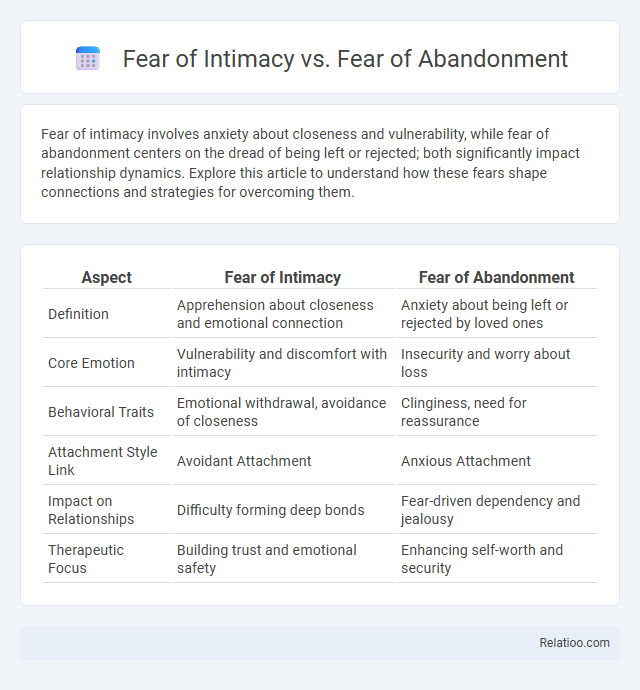Fear of intimacy involves anxiety about closeness and vulnerability, while fear of abandonment centers on the dread of being left or rejected; both significantly impact relationship dynamics. Explore this article to understand how these fears shape connections and strategies for overcoming them.
Table of Comparison
| Aspect | Fear of Intimacy | Fear of Abandonment |
|---|---|---|
| Definition | Apprehension about closeness and emotional connection | Anxiety about being left or rejected by loved ones |
| Core Emotion | Vulnerability and discomfort with intimacy | Insecurity and worry about loss |
| Behavioral Traits | Emotional withdrawal, avoidance of closeness | Clinginess, need for reassurance |
| Attachment Style Link | Avoidant Attachment | Anxious Attachment |
| Impact on Relationships | Difficulty forming deep bonds | Fear-driven dependency and jealousy |
| Therapeutic Focus | Building trust and emotional safety | Enhancing self-worth and security |
Understanding Fear of Intimacy
Fear of intimacy involves anxiety about emotional closeness and vulnerability in relationships, often stemming from past trauma or attachment issues. It differs from fear of abandonment, which centers on the dread of being left or rejected, and fear of intimacy may coexist with it but primarily concerns the discomfort with closeness itself. Understanding fear of intimacy requires recognizing its impact on trust, communication, and the ability to form deep, meaningful connections.
Understanding Fear of Abandonment
Understanding Fear of Abandonment involves recognizing the deep emotional anxiety rooted in the belief that loved ones will leave or reject you, which often stems from early attachment wounds. This fear can trigger intense feelings of insecurity, leading to clinginess, trust issues, and difficulty forming stable relationships. By addressing your Fear of Abandonment, you can build healthier connections based on trust and emotional security.
Key Differences Between the Two Fears
Fear of intimacy centers on the discomfort or anxiety about getting emotionally close to others, often stemming from vulnerability concerns, while fear of abandonment revolves around the worry of being rejected or left alone, typically rooted in past experiences of loss. Your fear of intimacy may cause you to avoid deep connections to protect yourself, whereas fear of abandonment can trigger clinginess or distrust to prevent perceived desertion. Recognizing these distinct fears is crucial for addressing emotional challenges and building healthier relationships.
Psychological Roots of Each Fear
Fear of intimacy originates from early attachment disruptions, often linked to inconsistent or neglectful caregiving, leading to difficulty in trusting others emotionally. Fear of abandonment stems from experiences of loss or rejection, causing heightened anxiety over being left alone, which triggers clinginess or avoidance in relationships. Your understanding of these fears deepens when recognizing how fear of intimacy and fear of abandonment, though related, arise from distinct psychological wounds impacting emotional connection and security.
Common Signs and Behaviors
Fear of intimacy often manifests through avoidance of close emotional connections, difficulty in trusting others, and reluctance to share personal feelings, resulting in superficial relationships. Fear of abandonment typically triggers clinginess, excessive jealousy, and constant reassurance-seeking to prevent perceived or real separation from loved ones. Both fears can cause emotional withdrawal, anxiety in relationships, and communication barriers, but fear of abandonment centers on loss, while fear of intimacy emphasizes vulnerability and connection.
Impacts on Relationships
Fear of intimacy, fear of abandonment, and fear of closeness each uniquely impact relationships by creating barriers to emotional connection and trust. Your ability to form secure bonds may be challenged by these fears, leading to withdrawal, clinginess, or difficulty in vulnerability. Addressing these fears through awareness and communication can enhance relationship stability and emotional fulfillment.
How These Fears Interact
Fear of intimacy often stems from vulnerability issues, while fear of abandonment involves anxiety about being left alone or rejected. These fears interact by creating a push-pull dynamic in relationships, where the desire for closeness conflicts with the dread of loss. Understanding this interplay is crucial for addressing relationship challenges and fostering emotional security.
Coping Mechanisms and Adaptive Strategies
Coping mechanisms for fear of intimacy often include setting gradual emotional boundaries and seeking consistent therapy to build trust and vulnerability. To address fear of abandonment, adaptive strategies emphasize developing secure attachment through open communication and practicing self-soothing techniques to manage anxiety. Overcoming fear of intimacy involves mindfulness exercises, fostering self-compassion, and engaging in supportive relationships that encourage emotional safety and connection.
Therapeutic Approaches for Each Fear
Therapeutic approaches for fear of intimacy often involve cognitive-behavioral therapy (CBT) to challenge negative beliefs about closeness and gradual exposure to emotional vulnerability. Fear of abandonment is frequently addressed through attachment-based therapy and dialectical behavior therapy (DBT) to enhance emotional regulation and develop secure relationship patterns. In treating fear of intimacy, emotion-focused therapy (EFT) helps clients process and express deep emotions, facilitating trust and connection in relationships.
Moving Toward Healthy Relationships
Fear of intimacy often stems from vulnerability concerns, while fear of abandonment centers on the anxiety of losing close connections, both impacting your ability to form deep bonds. Recognizing these fears allows you to address underlying insecurities and develop trust through open communication and emotional regulation. Moving toward healthy relationships involves practicing self-awareness, setting boundaries, and seeking consistent support to foster connection without overwhelming vulnerability or dependency.

Infographic: Fear of Intimacy vs Fear of Abandonment
 relatioo.com
relatioo.com